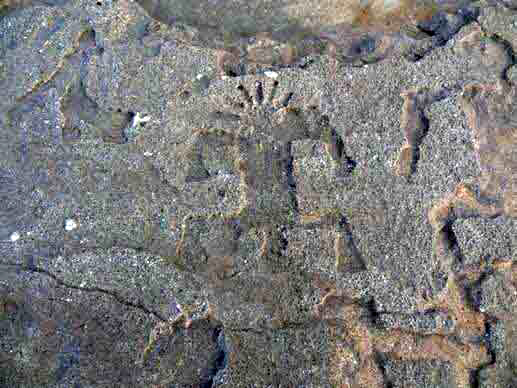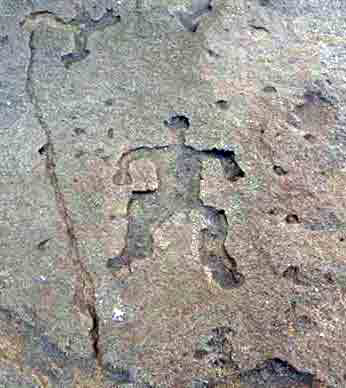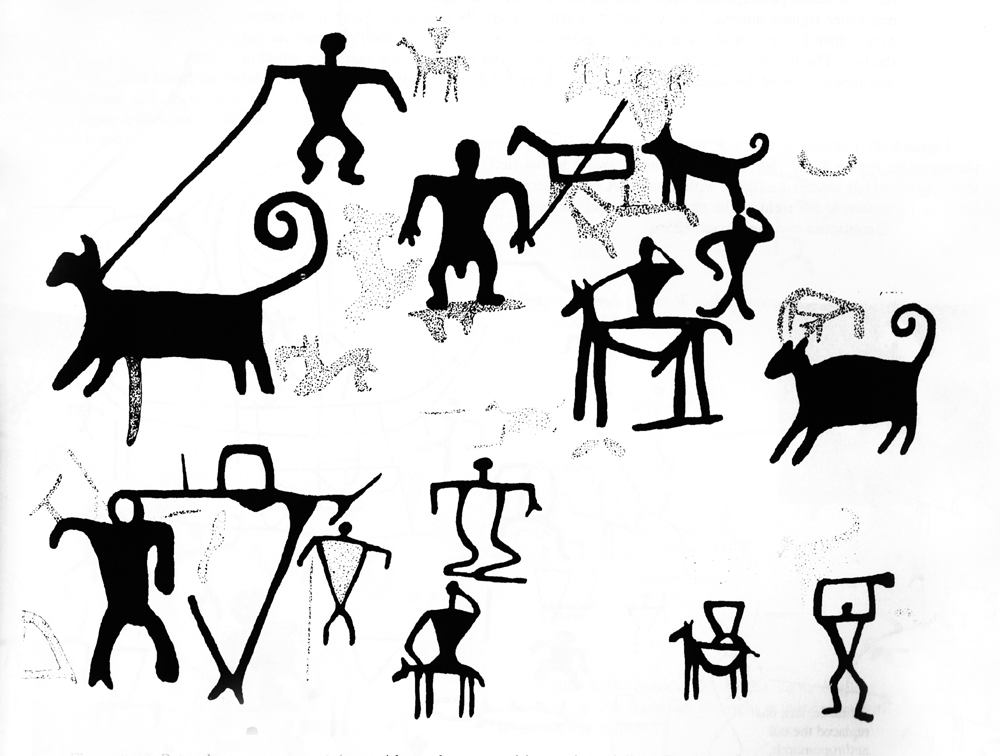


An article on Western Digs posted by Blake de Pastino - Monster Surf Exposes Rare Petroglyphs in Hawaii - reports on the recently exposed carvings.

Epic winter swells just off of Oahu, Hawaii, have churned up monster waves more than 7 meters high. Along with the damage there is the reveal - rare petroglyphs that have not been seen in years.
The unusually strong seasonal surf has washed away layers of sand all along Pupukea Beach, just east of the big-surf mecca of Waimea, to reveal dozens of large petroglyphs carved into the lava rock.

More than 70 carvings have been exposed, mostly depicting human-like figures and dogs, according to the Historic Hawaii Foundation, whose workers are documenting the images.
Social media have been rife with reports by surfers, beachcombers, and rock-art enthusiasts. By most accounts, the North Shore petroglyphs were last seen in 2010, when similar winter weather exposed some of them. Before that, they had not been observed since 2004.

Petroglyphs of men and dogs on Boulder 13, Luahiwa on Lanaa'i Island. Image: Georgia Lee
The appearance of the markings seems to coincide with El Nino, the periodic climate anomaly that causes unusually warm waters in the equatorial Pacific, and huge surf off of Oahu.
Research into Hawaiian petroglyphs, known locally as kii pohaku, has suggested that such carvings were used to document travels around and among the islands, to commemorate important events, and to mark trails and boundaries.
At Pu'u Loa, a vast field of more than 23,000 petroglyphs on Hawai'i's Big Island, many of the motifs are notable for featuring holes - cupules - in which Native Hawaiians deposited the umbilical cords of newborn babies.
In the publication Sprit of Place: Petroglyphs of Hawai'i by Georgia Lee and Edward Stasack, the authors explain that the petroglyphs of Hawai'i are more than captivating designs. To the ancient Polynesians they had meaning and significance, including a spiritual component.

Sprit of Place: Petroglyphs of Hawai'i by Georgia Lee and Edward Stasack
Easter Island Foundation, first published 1999
ISBN 1-880636-14-X
by Bradshaw Foundation
Friday 09 August 2024
by Bradshaw Foundation
Wednesday 24 July 2024
by Bradshaw Foundation
Thursday 04 July 2024
by Bradshaw Foundation
Monday 01 July 2024
by Bradshaw Foundation
Wednesday 20 March 2024
by Bradshaw Foundation
Tuesday 13 February 2024
by Bradshaw Foundation
Tuesday 13 February 2024
by Bradshaw Foundation
Thursday 01 February 2024
by Bradshaw Foundation
Tuesday 28 November 2023
by Bradshaw Foundation
Thursday 23 November 2023
by Bradshaw Foundation
Monday 20 November 2023
by Bradshaw Foundation
Tuesday 31 October 2023
by Bradshaw Foundation
Thursday 26 October 2023
by Bradshaw Foundation
Wednesday 20 September 2023
by Bradshaw Foundation
Monday 17 July 2023
by Bradshaw Foundation
Sunday 09 July 2023
by Bradshaw Foundation
Friday 09 August 2024
by Bradshaw Foundation
Wednesday 24 July 2024
by Bradshaw Foundation
Thursday 04 July 2024
by Bradshaw Foundation
Monday 01 July 2024
by Bradshaw Foundation
Wednesday 20 March 2024
by Bradshaw Foundation
Tuesday 13 February 2024
by Bradshaw Foundation
Tuesday 13 February 2024
by Bradshaw Foundation
Thursday 01 February 2024
by Bradshaw Foundation
Tuesday 28 November 2023
by Bradshaw Foundation
Thursday 23 November 2023
by Bradshaw Foundation
Monday 20 November 2023
by Bradshaw Foundation
Tuesday 31 October 2023
by Bradshaw Foundation
Thursday 26 October 2023
by Bradshaw Foundation
Wednesday 20 September 2023
by Bradshaw Foundation
Monday 17 July 2023
by Bradshaw Foundation
Sunday 09 July 2023
Friend of the Foundation











